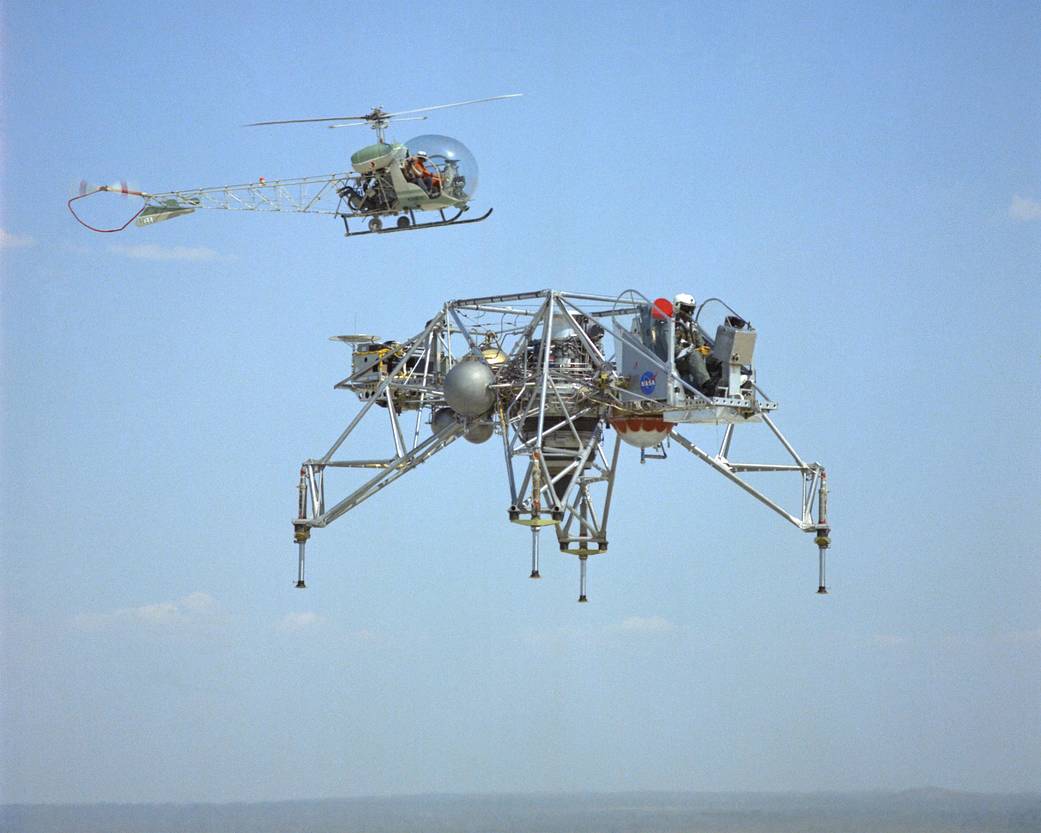
EC65-0649
Lunar Landing Research Vehicle (LLRV) flight #1-16-61F with Bell 47 Helicopter providing chase support. The use of chase planes was a critical part of flight research well before the establishment of what was then called the NACA Muroc Flight Test Unit in September 1947 (now the NASA Armstrong Flight Research Center). They act as a second set of eyes, warning the research pilot of any problems. When test flights of the LLRV began in October 1964, chase support for the vehicle was supplied by a Bell 47 helicopter. It could hover close by, providing information such as altitude and descent rate. LLRV test operations were phased out in late 1966 and early 1967.
When Apollo planning was underway in 1960, NASA was looking for a simulator to profile the descent to the Moon’s surface. Three concepts surfaced: an electronic simulator, a tethered device, and the ambitious NASA Flight Research Center (FRC) contribution, a free-flying vehicle. All three became serious projects, but eventually the NASA FRC Lunar Landing Research Vehicle (LLRV) became the most significant one. After conceptual planning and meetings with engineers from Bell Aerosystems Company, Buffalo, NY, NASA FRC issued a $3.6 million production contract awarded in 1963, for delivery of the first of two vehicles for flight studies.
Built of tubular aluminum alloy like a giant four-legged bedstead, the vehicle was to simulate a lunar landing profile from around 1500 feet to the Moon’s surface. The LLRV had a turbofan engine mounted vertically in a gimbal, with 4200 pounds of thrust. The engine, lifted the vehicle up to the test altitude and was then throttled back to support five-sixths of the vehicle’s weight, thus simulating the reduced gravity of the Moon. Two lift rockets with thrust that could be varied from 100 to 500 pounds handled the LLRV’s rate of descent and horizontal translations. Sixteen smaller rockets, mounted in pairs, gave the pilot control in pitch, yaw, and roll. The pilot’s platform extended forward between two legs while an electronics platform, similarly located, extended rearward. The pilot had a zero-zero ejection seat that would then lift him away to safety.
The two LLRVs were shipped from Bell to the FRC in April 1964, with program emphasis on vehicle #1. The first flight, Oct. 30, 1964, NASA research pilot Joe Walker flew it three times for a total of just under 60 seconds, to a peak altitude of approximately 10 feet. By mid-1966 the NASA Flight Research Center had accumulated enough data from the LLRV flight program to give Bell a contract to deliver three Lunar Landing Training Vehicles (LLTVs) at a cost of $2.5 million each. 1966 ended with the phasing out of the Flight Research Center’s portion of the LLRV program. The LLRV #1 had flown 198 flights, with flight times reaching 9-1/2 minutes and altitudes of around 750 feet. In December 1966 vehicle #1 was shipped to NASA Manned Spacecraft Center, followed by #2 in mid January 1967 with a total of six flights. The two LLRV’s were soon joined by the three LLTV’s. All five vehicles were relied on for simulation and training of Moon landings.April 26, 1965NASA Photo› Read LLRV Project Description

























